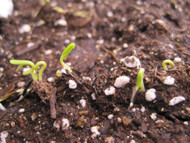How to Store Food Plot Seed for Future Planting
How to Store Food Plot Seed for Future Planting
W. Carrol Johnson, III, PhD Agronomist and Weed Scientist Whitetail Institute of North America
When it comes to planting food plots, fresh seed is always the gold standard. But let’s face it, plans change. Maybe a drought derailed your planting schedule, or you ended up with more seed than you needed. Whatever the reason, you’re left wondering: can I save this seed for next season?
The short answer is yes, with a few important caveats.
The Basics of Seed Storage
If you’re holding onto leftover food plot seed, proper storage is critical. Seeds are living organisms, and their viability depends on how well they’re protected from moisture and temperature fluctuations.
Here’s how to do it right:
- Dry and cold is the goal: Moisture and heat are the enemies of seed longevity.
- Use sealed containers: Airtight jars, vacuum-sealed packets, or moisture-proof bags work best.
- Acclimate before freezing: Let the seed adjust to room temperature before sealing to prevent condensation.
- Store in a freezer: A freezer offers colder and drier air than a refrigerator, making it the better option for long-term storage.
Which Seeds Store Well and Which Don’t
Not all seeds are created equal when it comes to shelf life. Some retain their germination power better than others such as clover, brassicas and cereal grains.
Some seed quickly lose viability, regardless of storage conditions. Seed viability in storage varies among crop species and storage conditions.
Test Before You Store
Before you sow stored seed, it’s wise to test its germination rate. Two simple methods can give you a clear picture:
- Potting soil test: Plant a small sample in a shallow pan of potting soil and monitor sprouting.
- Ragdoll test: Place seeds in a moistened paper towel, roll it up, and seal it in a plastic bag. Keep it in a warm spot for a few days and check for sprouting.
These tests help you gauge how much seed is still viable and whether you need to adjust your seeding rate to compensate for reduced germination.
Final Thoughts
Storing food plot seed is doable with care. Always test before planting and be prepared to increase your seeding rate if germination is low. And if the test results are poor? Invest in fresh seed next season.
Your food plot’s success starts with strong, viable seed and a little planning today can save you time, money, and frustration next season.



